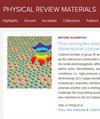Vacancy-mediated transport and segregation tendencies of solutes in fcc nickel under diffusional creep: A density functional theory study
IF 3.4
3区 材料科学
Q2 MATERIALS SCIENCE, MULTIDISCIPLINARY
引用次数: 0
Abstract
The Nabarro-Herring (NH) diffusional creep theory postulates the vacancy-mediated transport of atoms under a stress gradient as the creep mechanism under low-stress and high-temperature conditions. In multicomponent alloys, we premise that this stress-assisted flow of vacancies to and from grain boundaries will produce elemental segregation. An observation of such segregation, validated with theoretical predictions, can provide the necessary experimental evidence for the occurrence of NH creep. Theoretical calculations of the segregation tendencies via analyzing the dominant solute diffusion mechanisms and the difference in diffusivities of the elements are therefore essential. To this end, this study applies density functional theory calculations of migration barriers and solute-vacancy binding energies as input to the self-consistent mean-field theory to assess the vacancy-mediated diffusion mechanisms, transport coefficients, and segregation tendencies of Co, Cr, Mo, Re, Ta, and W solutes in face-centered-cubic Ni. We find Co, Re, and W to be slow diffusers at high temperatures and Cr, Mo, and Ta to be fast diffusers. Further analysis shows that the slow diffusers tend to always enrich at vacancy sinks over a wide range of temperatures. In contrast, the fast diffusers show a transition from depletion to enrichment as the temperature lowers. Furthermore, our analysis of the segregation tendencies under tensile hydrostatic strains shows that slow diffusers are largely unaffected by the strain and favor enrichment. On the other hand, the fast diffusers exhibit high sensitivity to strain and their segregation tendency can transition from depletion to enrichment at a given temperature. The transport coefficients calculated in this work are expected to serve as input to mesoscale microstructure models to provide a more rigorous assessment of solute segregation under NH creep conditions.

扩散蠕变条件下 fcc 镍中溶质的空位介导迁移和偏析趋势: 密度泛函理论研究
纳巴罗-赫林(NH)扩散蠕变理论假定,在低应力和高温条件下,原子在应力梯度下的空位迁移是蠕变机制。在多组分合金中,我们假设空位在应力作用下进出晶界会产生元素偏析。观察到这种偏析并与理论预测进行验证,可以为 NH 蠕变的发生提供必要的实验证据。因此,通过分析主要的溶质扩散机制和元素扩散率的差异来对偏析趋势进行理论计算是至关重要的。为此,本研究将迁移障碍和溶质-空位结合能的密度泛函理论计算作为自洽平均场理论的输入,以评估面心立方 Ni 中 Co、Cr、Mo、Re、Ta 和 W 溶质的空位介导扩散机制、迁移系数和偏析倾向。我们发现 Co、Re 和 W 在高温下扩散速度较慢,而 Cr、Mo 和 Ta 扩散速度较快。进一步的分析表明,在很宽的温度范围内,慢速扩散者往往总是在空位汇处富集。与此相反,随着温度的降低,快速扩散体显示出从耗尽到富集的过渡。此外,我们对拉伸静水应变下的偏析趋势进行的分析表明,慢速扩散器基本上不受应变的影响,并倾向于富集。另一方面,快速扩散器表现出对应变的高度敏感性,在给定温度下,它们的偏析趋势会从贫化过渡到富集。这项工作计算出的迁移系数有望作为中尺度微结构模型的输入,从而对 NH 蠕变条件下的溶质偏析进行更严格的评估。
本文章由计算机程序翻译,如有差异,请以英文原文为准。
求助全文
约1分钟内获得全文
求助全文
来源期刊

Physical Review Materials
Physics and Astronomy-Physics and Astronomy (miscellaneous)
CiteScore
5.80
自引率
5.90%
发文量
611
期刊介绍:
Physical Review Materials is a new broad-scope international journal for the multidisciplinary community engaged in research on materials. It is intended to fill a gap in the family of existing Physical Review journals that publish materials research. This field has grown rapidly in recent years and is increasingly being carried out in a way that transcends conventional subject boundaries. The journal was created to provide a common publication and reference source to the expanding community of physicists, materials scientists, chemists, engineers, and researchers in related disciplines that carry out high-quality original research in materials. It will share the same commitment to the high quality expected of all APS publications.
 求助内容:
求助内容: 应助结果提醒方式:
应助结果提醒方式:


